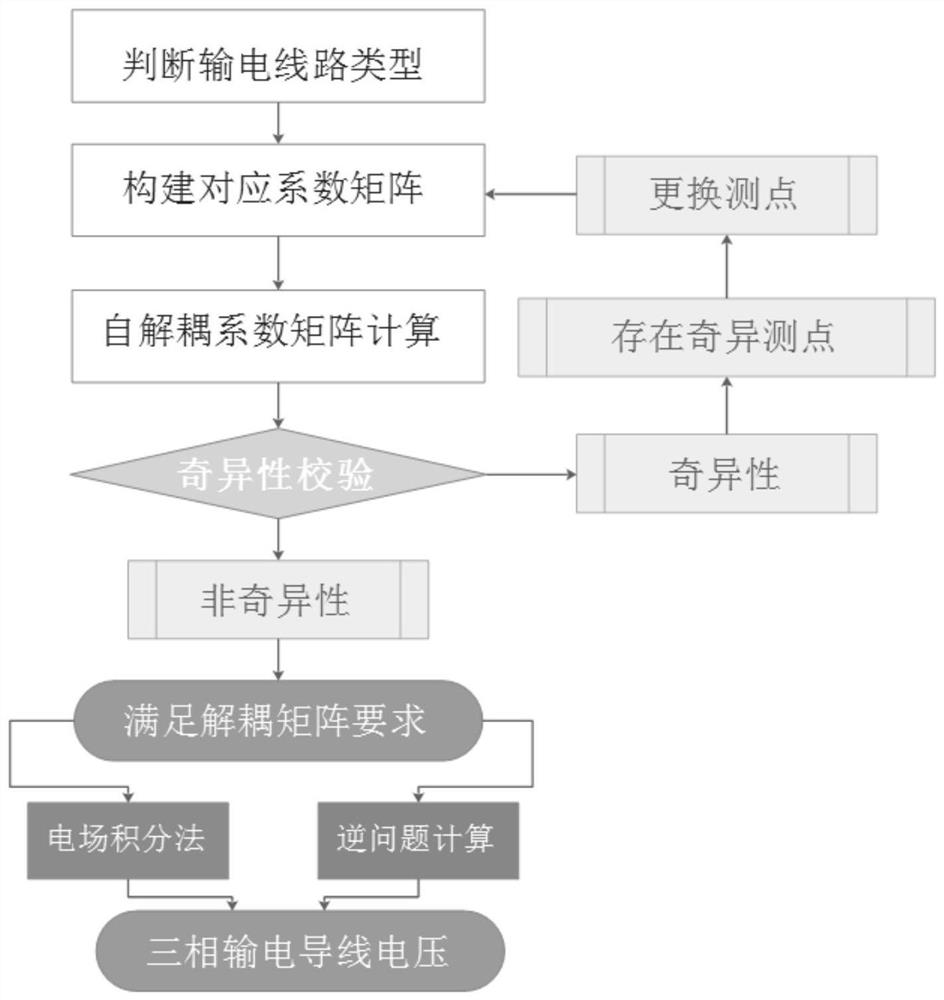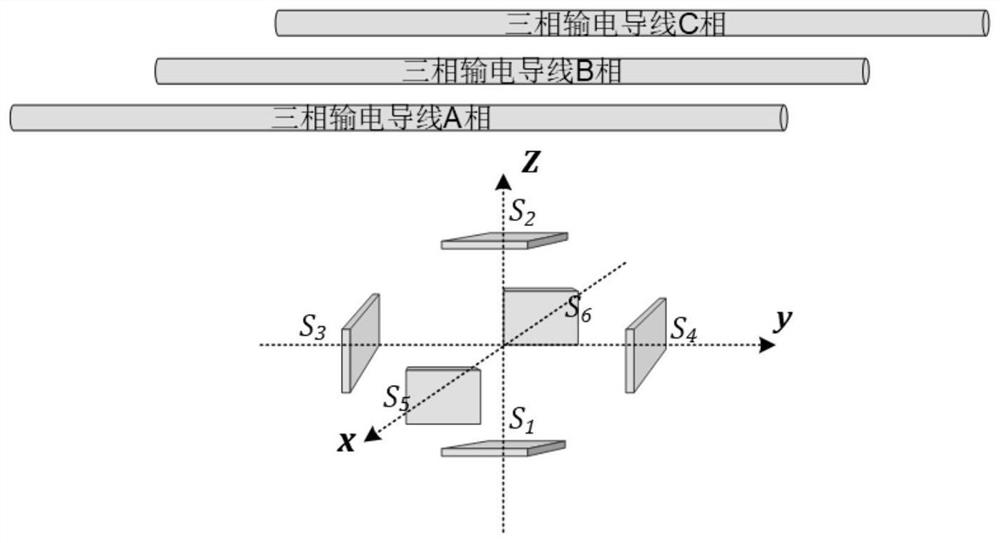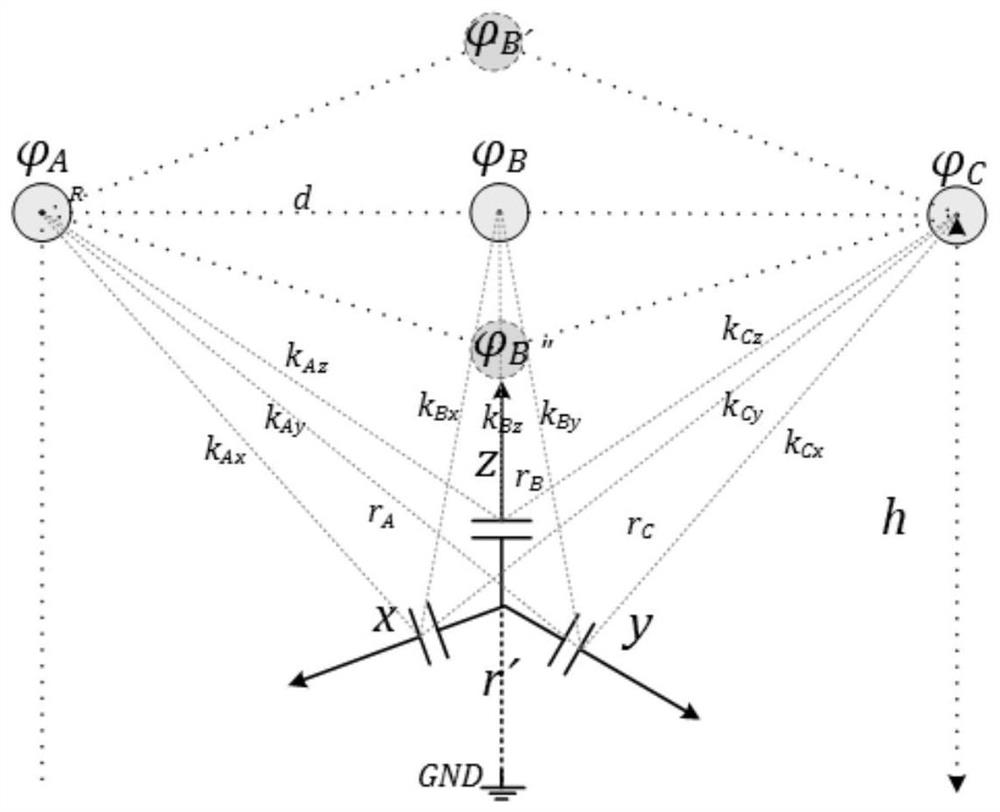Voltage measurement self-decoupling method based on multi-dimensional equivalent capacitance calculation
An equivalent capacitance and voltage measurement technology, applied in the field of electronic information, can solve the problems of high sensor installation location requirements, calibration error, large calibration workload, etc., to improve measurement accuracy and application adaptability, self- The effect of decoupling matrix coefficients to simplify and improve computational efficiency
- Summary
- Abstract
- Description
- Claims
- Application Information
AI Technical Summary
Problems solved by technology
Method used
Image
Examples
Embodiment 1
[0057] see Figure 1 to Figure 3 , a voltage measurement self-decoupling method based on multidimensional equivalent capacitance calculation, including the following steps:
[0058] 1) Determine the type of transmission line to be tested;
[0059] The types of transmission lines to be tested include three-phase horizontal transmission lines, inverted triangle transmission lines, and forward triangle transmission lines.
[0060] 2) Using a non-contact voltage sensor, measure the electric field at the position of the measuring point, and establish the self-decoupling matrix (ie, the self-decoupling coefficient matrix) of the transmission line to be tested.
[0061] The non-contact electric field sensor is a three-dimensional omnidirectional electric field coupled non-contact electric field sensor.
[0062] The three-dimensional omnidirectional electric field coupled non-contact electric field sensor includes a number of induction plates located in the three-dimensional directi...
Embodiment 2
[0095] see Figure 1 to Figure 3 , a voltage measurement self-decoupling method based on multidimensional equivalent capacitance calculation, including the following steps:
[0096] 1) Determine the type of transmission line to be tested;
[0097] The types of transmission lines to be tested include three-phase horizontal transmission lines, inverted triangle transmission lines, and forward triangle transmission lines.
[0098] 2) Use a non-contact electric field sensor to measure the voltage of the transmission line to be tested in a non-contact manner, and establish a self-decoupling matrix of the transmission line to be tested; the sensors are distributed symmetrically based on the x and z axes.
[0099] The non-contact electric field sensor is a three-dimensional omnidirectional electric field coupled non-contact electric field sensor.
[0100] The three-dimensional omnidirectional electric field coupled non-contact electric field sensor includes several induction plates...
Embodiment 3
[0122] see Figure 1 to Figure 3 , a voltage measurement self-decoupling method based on multidimensional equivalent capacitance calculation, including the following steps:
[0123] 1) Determine the type of transmission line to be tested;
[0124] The types of transmission lines to be tested include three-phase horizontal transmission lines, inverted triangle transmission lines, and forward triangle transmission lines.
[0125] 2) Use a non-contact electric field sensor to measure the voltage of the transmission line to be tested in a non-contact manner, and establish a self-decoupling matrix of the transmission line to be tested; the sensor generates Δ on the y-o-z plane y = l y ,Δ z = l z offset. Δ y = l y Indicates that the sensor is offset in the y-axis direction, and the offset is l y . Δ z =lz means that the sensor is offset in the z-axis direction, and the offset is l z .
[0126] The non-contact electric field sensor is a three-dimensional omnidirectional e...
PUM
 Login to View More
Login to View More Abstract
Description
Claims
Application Information
 Login to View More
Login to View More - R&D
- Intellectual Property
- Life Sciences
- Materials
- Tech Scout
- Unparalleled Data Quality
- Higher Quality Content
- 60% Fewer Hallucinations
Browse by: Latest US Patents, China's latest patents, Technical Efficacy Thesaurus, Application Domain, Technology Topic, Popular Technical Reports.
© 2025 PatSnap. All rights reserved.Legal|Privacy policy|Modern Slavery Act Transparency Statement|Sitemap|About US| Contact US: help@patsnap.com



